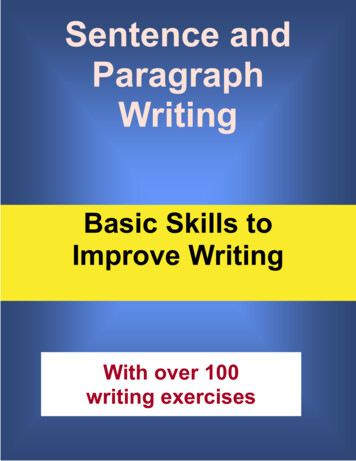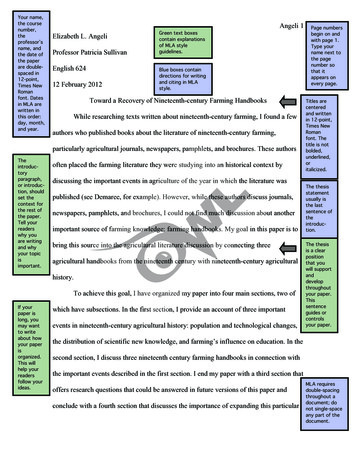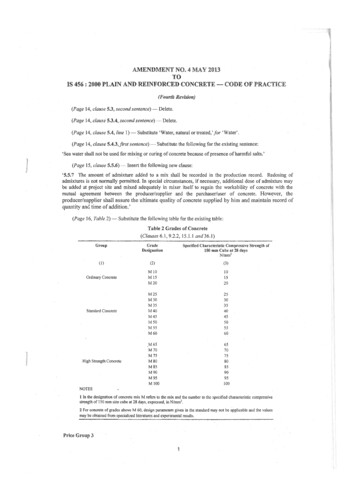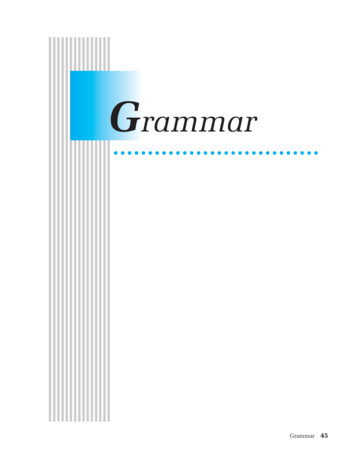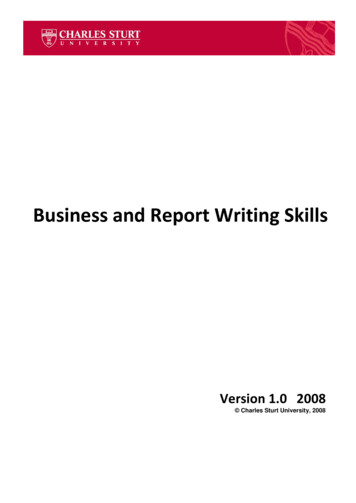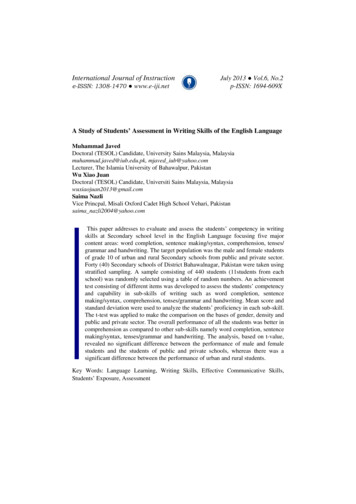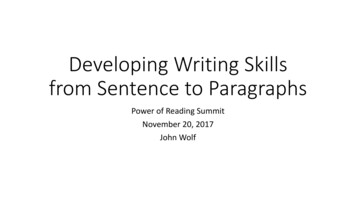
Transcription
Developing Writing Skillsfrom Sentence to ParagraphsPower of Reading SummitNovember 20, 2017John Wolf
Indiana Academic Standards for WritingIndiana Academic Standards require studentsto become proficient in multiple text types– Handwriting– Persuasive– Informative– Narrative– The Research Process
What Works Clearinghouse
Five Recommendations for TeachingCommon Core Grammar to Elementary Students
Critical Foundational Skills Transcription skills– Handwriting– Spelling Composition skills– Words to sentences, paragraphs, and essays– Creating, organizing, elaborating ideas– Editing, revising, sharing(Berninger & Winn, 2006; McCloskey & Perkins, 2012)
Handwriting Linked to better letter perception, reading fluency, and writingfluency (Berninger, 2012; Graham, Harris, & Fink, 2000) Trains the orthographic loop, which supports spelling andcomposing. Trains serial organization Automaticity – quickly, accurately, effortlessly Reduces cognitiveload needed for composition
Why Handwriting Instruction?1. Learning to form letters by hand improves perception of lettersand contributes to better reading and spelling.2. Automatic letter writing promotes better composing—bothamount written and quality of writing. (Berninger, 2012)What about Keyboarding?
SpellingSpelling instruction:– in the early grades is linked to better composition in the latergrades. (Berninger & Fayol, 2008)– is linked to greater phonological awareness and readingproficiency (Graham & Santangelo, 2011)
Oral Language Skills Vocabulary – Writers must be able to spontaneously recall wordsand have a clear understanding of word meaning and usage.(Corona, Spangenberger, & Venet, 1998) Sentence construction – practice in combining simple, shortsentences into complex sentences improves writing quality(Saddler & Graham, 2005)
Writing ProcessExplicit instruction in the writing process – plan, draft,revise, edit, and publish – is supported by multiplestudies. (Graham & Perin, 2007)
Writing Instruction Strategy instruction is effective in increasing overall quality ofstudents’ writing (Graham, 2006) and has long-term impact (Fidalgo,Torrance, & Garcia, 2008) Instruction should include:– task-specific strategies (i.e., using graphic organizers)and– metacognitive strategies (i.e., using a rubric to evaluation your draft)
Writing Instruction Recommendations Provide ample time for writing Use frequent assessment to inform instruction Explicitly teach writing skills, process and strategies Teach multiple text types Write across the curriculum Integrate appropriate technology Establish a positive environment for writing(Graham, 2013)
Writing Mini-Lesson1.2.3.4.Give the lesson a catchy name.Keep it brief.Focus on 1 key learning concept.Let the student know up frontwhat they will be learning.5. Start by connecting the lessonwith what they already know orare already doing.6. Be explicit and direct.7. Expect students to be accountablefor their learning.8. Plan mini-lessons based on whatyour students need to know.9. Once is never enough!
Model for Explicit Teaching in Writer’s WorkshopI’ll Show YouYou Help MeI’ll Help YouNow You Do ItYourselfTeacherdemonstration inmini-lessons:Teacher has all theresponsibility for thewritingClass participation inmini-lessons:The teacher has themost responsibilityfor the writing andthe childrencontribute as theyare ableAt-the-elbowconferences:The child has themost responsibilityfor the writing andthe teacher providessupport as needed.IndependentWriting:The child has all theresponsibility for thewritingTeacher ResponsibilityStudent Responsibility
Text Structure to Improve Reading ComprehensionUnderstanding text structure Narrative - Tells a story, often about personal events or other lifeexperiences; may be fiction or nonfiction Informational -Convey facts, describe procedures, explainsomething, share basic information, relate cause-effect,compare/contrast, problem-solution structures
Text Structure Strategy:Free Response – ask students to record (oral orwritten) a response to queries such as:– I like.– I wonder .– I think .– I learned .– This reminds me of .– I am surprised .– I want to know .(Step Up To Writing, Grades K-2 Auman, 2016
Ask and Answer Questions about a TextNarratives Who are the characters? Who is the story about? What is the story about? What is the problem? What might happen? When does the story take place? Where does the story take place? Where do the characters go? Why does the character do this? Why does the character feel this way? How would your retell the story? How would you describe thecharacter? How does the character solvethe problem?(Step Up To Writing, Grades K-2 Auman, 2016)
Ask and Answer Questions about a TextInformational What is the topic of the text? What information did you learn? Who is involved? When did this happen? When would you use this information? Where did this happen? Where would you see this in the world? Why is this topic important? Why did this happen? How would your describe this to someone else?(Step Up To Writing, Grades K-2 Auman, 2016)
Writing Composition Skills Print conventions – capitalization, punctuation, grammar, spelling Language usage and style Ideas and content Organization
Writing Process Prewrite or draw – think about a topic Plan – organize ideas Draft – write or tell first copy Revise – make writing more clear and interesting Edit – word usage, spelling, capitals, punctuation Final copy and proofread Share and publish
Sentence WritingLearning parts of speechWho or WhatFirst TryBetter SentenceThe dogActionIs runningWhere, Whenor Howaway
Sentence WritingMore parts of speechWhatActionHowWhere
Combining Sentences The boy drank lemonade. The boy was thirsty. The weather was perfect. The girls were playing soccer.
Writing ParagraphsThree-Sentence Paragraph Topic titleGrowing Pumpkins Beginning sentencePumpkins grow in gardens. Two important ideasThey are big and orange.You can make pumpkin pie from pumpkins.
Deepen Vocabularies with Definitions Word– Category– Is like– Is not like– Definition– Connection to self
Describing with the 5 SensesSeeHearSmellFeelTaste
QUESTION-to solicit more details: What type of . Is that allowed. When does he. What color is.Always follow with “HOW CAN YOU ADD THOSE DETAILS?”The focus should be on “How can you add them?”not “Would you like to add.”
Some Positive Things to Do or Say Your reader will like the wayyou have. Your reader can picture. This piece is easy for me toread. How did you learn that? I do the same thing. Tell me again what happened.Did you put it down that way? What else do you want thereader to know? How did you select the topic? I see you have included somewords from the word wall. I see you used
Shades of MeaningTemperaturesteamyfrigidchillytepid
Information WritingOne Paragraph Structure Topic sentence Key idea Examples, explanations, events, experiences Concluding sentence(Step Up To Writing, Grades K-2 Auman, 2016)
Informative WritingLonger Paragraph Structure Topic sentence Key ideaExamples, explanations, events, experiences Key ideaExamples, explanations, events, experiences Key ideaExamples, explanations, events, experiences Concluding sentence(Step Up To Writing, Grades K-2 Auman, 2016)
Title: ElephantsTopic: Two kinds of elephantsConclusion:(Step Up To Writing, Grades K-2 Auman, 2016)
Persuasive WritingSimilar structure as informative writingTopicKey idea Examples, explanations, events, experiencesConclusion(Step Up To Writing, Grades K-2 Auman, 2016)
Topic/Opinion : Best snacksSnacksWhy they are the best(Step Up To Writing, Grades K-2 Auman, 2016)
Narrative WritingFiction and nonfiction Real or imagined experiences and events Teach strategies to write a beginning, middle and ending
Steps to Writing a StoryStep 1Use 1 way to start: Tell who,where, when, or an actionStep 2What happens next?Step 3Add more details.(Step Up To Writing, Grades K-2 Auman, 2016)
Ways to End a Story Share a feeling Remember a character Share what the character may have learned
Research Reports Model the research process by leading shared classroomresearch projects. Help students create research questions. Help to identify useful sources (print and digital) related to theirtopics. Provide practice opportunities. Have students present their projects.(Step Up To Writing, Grades K-2 Auman, 2016)
Assessment Strategies Use student rubrics for revision based on the writing processes– Organization– Ideas– Style Use student rubrics for editing of word usage, spelling, capitalizationand punctuation.(Step Up To Writing, Grades K-2 Auman, 2016)
Writing TAGT TellI like the way you.I heard you say.A Ask a questionWhat did you mean when you said.What happened before.or after.G Give a suggestionMaybe you can use a better word for.Tell me more about .
Take-Home Points Writing is a critical skill for all children. Handwriting and spelling facilitate composition skills. Explicit instruction at all levels is a proven, evidence-basedapproach to teaching writing.
SeeSaw Digital Portfolio
Free Support ToolsK-6 Writing gjxZg/k-6-writing-tools-supportWriting iting-focusWriting Support iting-support-tools
Nov 20, 2017 · Writing Instruction Recommendations Provide ample time for writing Use frequent assessment to inform instruction Explicitly teach writing skills, process and strategies Teach multiple text types Write across the curriculum Integrate appropriate technology Establish a positiv
